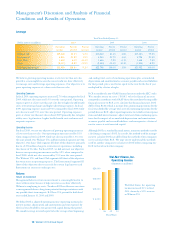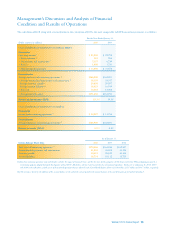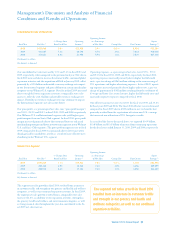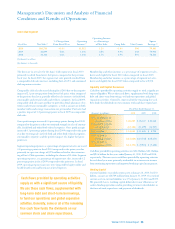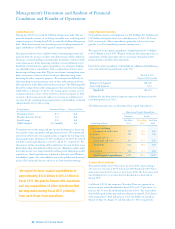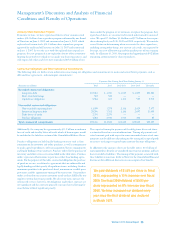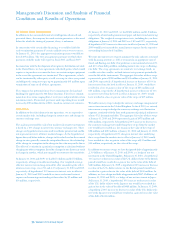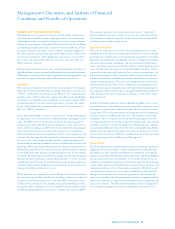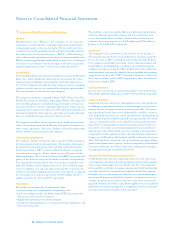Walmart 2010 Annual Report Download - page 28
Download and view the complete annual report
Please find page 28 of the 2010 Walmart annual report below. You can navigate through the pages in the report by either clicking on the pages listed below, or by using the keyword search tool below to find specific information within the annual report.Off Balance Sheet Arrangements
In addition to the unrecorded contractual obligations discussed and
presented above, the company has made certain guarantees as discussed
below for which the timing of payment, if any, is unknown.
In connection with certain debt financing, we could be liable for
early termination payments if certain unlikely events were to occur.
At January 31, 2010, the aggregate termination payment would have
been $109 million. The two arrangements pursuant to which these
payments could be made will expire in fiscal 2011 and fiscal 2019.
In connection with the development of our grocery distribution network
in the United States, we have agreements with third parties which would
require us to purchase or assume the leases on certain unique equipment
in the event the agreements are terminated. These agreements, which
can be terminated by either party at will, cover up to a five-year period
and obligate the company to pay up to approximately $41 million upon
termination of some or all of these agreements.
The company has potential future lease commitments for land and
buildings for approximately 348 future locations. These lease commit-
ments have lease terms ranging from 1 to 40 years and provide for certain
minimum rentals. If executed, payments under operating leases would
increase by $59 million for fiscal 2011, based on current cost estimates.
Market Risk
In addition to the risks inherent in our operations, we are exposed to
certain market risks, including changes in interest rates and changes in
currency exchange rates.
The analysis presented for each of our market risk sensitive instruments
is based on a 10% change in interest or currency exchange rates. These
changes are hypothetical scenarios used to calibrate potential risk and do
not represent our view of future market changes. As the hypothetical
figures discussed below indicate, changes in fair value based on the assumed
change in rates generally cannot be extrapolated because the relationship
of the change in assumption to the change in fair value may not be linear.
The effect of a variation in a particular assumption is calculated without
changing any other assumption. In reality, changes in one factor may result
in changes in another, which may magnify or counteract the sensitivities.
At January 31, 2010 and 2009, we had $37.3 billion and $37.2 billion,
respectively, of long-term debt outstanding. Our weighted-average
effective interest rate on long-term debt, after considering the effect
of interest rate swaps, was 4.5% and 4.4% at January 31, 2010 and 2009,
respectively. A hypothetical 10% increase in interest rates in effect at
January 31, 2010 and 2009 would have increased annual interest
expense on borrowings outstanding at those dates by $9 million and
$16 million, respectively.
At January 31, 2010 and 2009, we had $523 million and $1.5 billion,
respectively, of outstanding commercial paper and short-term borrowing
obligations. The weighted-average interest rate, including fees, on these
obligations at January 31, 2010 and 2009 was 1.8% and 0.9%, respectively.
A hypothetical 10% increase in these rates in effect at January 31, 2010 and
2009 would have increased the annual interest expense for the respective
outstanding balances by $1 million.
We enter into interest rate swaps to minimize the risks and costs associated
with financing activities, as well as to maintain an appropriate mix of
fixed- and floating-rate debt. Our preference is to maintain between 40%
and 60% of our debt portfolio, including interest rate swaps, in floating-
rate debt. The swap agreements are contracts to exchange fixed- or
variable-rates for variable- or fixed-interest rate payments periodically
over the life of the instruments. The aggregate fair value of these swaps
represented a gain of $240 million and $304 million at January 31, 2010
and 2009, respectively. A hypothetical increase or decrease of 10% in
interest rates from the level in effect at January 31, 2010, would have
resulted in a loss or gain in value of the swaps of $25 million and
$24 million, respectively. A hypothetical increase or decrease of 10%
in interest rates from the level in effect at January 31, 2009, would
have resulted in a loss or gain in value of the swaps of $17 million.
We hold currency swaps to hedge the currency exchange component of
our net investments in the United Kingdom. In fiscal 2010, we entered
into currency swaps to hedge the currency exchange rate fluctuation
exposure associated with the forecasted payments of principal and interest
of non-U.S. denominated debt. The aggregate fair value of these swaps
at January 31, 2010 and 2009 represented a gain of $475 million and
$526 million, respectively. A hypothetical 10% increase or decrease in
the currency exchange rates underlying these swaps from the market
rate would have resulted in a loss or gain in the value of the swaps of
$58 million and $150 million at January 31, 2010 and January 31, 2009,
respectively. A hypothetical 10% change in interest rates underlying
these swaps from the market rates in effect at January 31, 2010 would
have resulted in a loss or gain in value of the swaps of $11 million and
$30 million, respectively, on the value of the swaps.
In addition to currency swaps, we have designated debt of approximately
£3.0 billion as of January 31, 2010 and 2009, as a hedge of our net
investment in the United Kingdom. At January 31, 2010, a hypothetical
10% increase or decrease in value of the U.S. dollar relative to the British
pound would have resulted in a gain or loss in the value of the debt of
$480 million. At January 31, 2009, a hypothetical 10% increase or decrease
in value of the U.S. dollar relative to the British pound would have
resulted in a gain or loss in the value of the debt of $440 million. In
addition, we have designated debt of approximately ¥437.4 billion as of
January 31, 2010 and 2009, as a hedge of our net investment in Japan.
At January 31, 2010, a hypothetical 10% increase or decrease in value
of the U.S. dollar relative to the Japanese yen would have resulted in a
gain or loss in the value of the debt of $485 million. At January 31, 2009,
a hypothetical 10% increase or decrease in value of the U.S. dollar rela-
tive to the Japanese yen would have resulted in a gain or loss in the value
of the debt of $443 million.
Management’s Discussion and Analysis of Financial
Condition and Results of Operations
26 Walmart 2010 Annual Report




